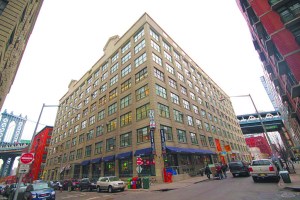 Dumbo got its name because artists in the ’70s hoped the ridiculous moniker would keep development out. One resident even told The New York Times she resented the first Coke machine to go in the neighborhood.
Dumbo got its name because artists in the ’70s hoped the ridiculous moniker would keep development out. One resident even told The New York Times she resented the first Coke machine to go in the neighborhood.
David Walentas ignored this. He forged, then pacified Dumbo, starting when punk rockers had barely discovered the East Village. His timing and formula were spot on.
Take 55 Washington Street, a commercial anchor for the neighborhood. A 2001 article describes office space there as featuring “carpeting … and electric wiring.” The Real Estate Weekly piece quoted a Newmark broker saying, “Tenants here get the luxury of exceptional space with every modern amenity.” You had to sell Brooklyn back then, baby!
Not 10 years later, and 55 Washington Street mixes tenants ranging from lawyers to postmodern artists. Recent moves by construction contractor Skanska Koch, which is working on the Brooklyn Bridge retrofit, and Spike Lee’s production company, Forty Acres and a Mule, have filled out 55 Washington. Law firm McMahon, Martine & Gallagher also calls 55 Washington home, as does educational software developer Wireless Generation, which, like many tenants in the area, took advantage of the city’s tax incentive REAP (relocation and employment assistance program) for its spot. Down the street, Brooklyn’s priciest apartment listing ever recently debuted. The penthouse, at 1 Main Street, another Walentas property, has an asking price of $25 million.
The prebuilt, loft-style office 55 Washington sits between Water and Front streets, appropriate as it looks out onto a gorgeous waterfront. Or at least now it does. Before its renaissance, dead bodies used to regularly wash up on these shores, and this little stretch of Brooklyn, sequestered by the BQE, consisted mostly of abandoned factories. Somehow, Mr. Walentas saw in it the next Soho.
He and his Two Trees Management eventually bought up 15 buildings in Dumbo, and re-engineered the neighborhood according to a transparent gentrification master plan that involves giving more than 1,000 artists and arts organizations free rent.
He has also won the favor of community groups and the public, which is quite a feat for a real estate developer in this part of town. (At the annual “Arts Under the Bridge” festival in 2006, both sides of the Dumbo-into-Soho debate agitated. A vintage carousel, restored by artist Jane Walentas, the developer’s wife, was on display on Water Street; just down the block, at the loading dock of the Foragers’ Market, a high-end grocer, the “Death of DUMBO” parade was forming. The parade tromped through the Belgian-block-clad streets loudly mourning the death of the neighborhood.)
Mr. Walentas has said repeatedly that part of his marketing philosophy is courting artists, and not just to propel an initial surge in rent, but to sustain the neighborhood. Among the creative tenants at 55 Washington is the handmade craft purveyor etsy.com, which also hosts weekly instructional craft-making parties. Mr. Walentas has said that artists are “like good architecture … they add value to a building.”


